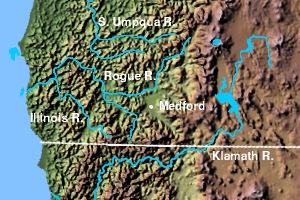Rogue Valley AVA
Rogue Valley AVA is an American Viticultural Area (AVA) located in the southern part of Oregon, United States. It is part of the larger Southern Oregon AVA and encompasses three primary river valleys: the Bear Creek Valley, the Applegate Valley, and the Illinois Valley. These valleys extend from the city of Grants Pass in the west to Ashland in the east. The Rogue Valley AVA was officially designated in 1991, recognizing its unique climate, soil types, and elevation that distinguish it from other wine-growing regions in Oregon.
Geography and Climate[edit | edit source]
The Rogue Valley AVA is characterized by its diverse geography, ranging from the steep, mountainous terrain in the west to the rolling hills and flatlands in the east. The region benefits from a transitional climate between the cooler, maritime influences of the Pacific Ocean and the hotter, drier conditions found further inland. This climatic diversity allows for a wide variety of grapes to be grown, including both cool-climate varieties such as Pinot noir and Chardonnay, and warmer-climate varieties like Merlot, Cabernet Sauvignon, and Syrah.
Viticulture[edit | edit source]
Viticulture in the Rogue Valley dates back to the 1850s, making it one of the oldest wine-producing areas in Oregon. The region's complex topography and varied climate create microclimates that are well-suited to specific grape varieties. Vineyards are typically planted at elevations ranging from 1,200 to 2,000 feet, allowing for a longer growing season and optimal grape ripening conditions. The soil in the Rogue Valley is predominantly composed of sedimentary, metamorphic, and volcanic origins, which contribute to the distinctive terroir of its wines.
Wineries and Wines[edit | edit source]
The Rogue Valley AVA is home to over 150 wineries and vineyards, making it a significant player in Oregon's wine industry. The region is known for producing high-quality, artisanal wines that reflect the unique characteristics of its terroir. While the Rogue Valley produces a diverse array of wine styles, it is particularly renowned for its robust red wines, such as Cabernet Sauvignon, Merlot, and Syrah, which exhibit deep flavors, complex aromas, and a well-balanced structure.
Tourism[edit | edit source]
Wine tourism is a vital part of the Rogue Valley's economy, with many wineries offering tasting rooms, tours, and wine-related events throughout the year. The region's scenic beauty, combined with its cultural attractions and outdoor recreational opportunities, makes it a popular destination for wine enthusiasts and tourists alike.
Challenges and Opportunities[edit | edit source]
Like many wine-growing regions, the Rogue Valley faces challenges such as climate change, water management, and land use pressures. However, the region's winemakers and grape growers are actively engaged in sustainable viticulture practices, research, and innovation to address these challenges and ensure the long-term viability of the Rogue Valley as a premier wine-producing area.
Conclusion[edit | edit source]
The Rogue Valley AVA is a dynamic and diverse wine region that plays a crucial role in Oregon's wine industry. Its unique combination of geographic, climatic, and soil conditions allows for the production of a wide range of high-quality wines. As the Rogue Valley continues to evolve and grow, it remains a testament to the rich viticultural heritage and innovative spirit of Oregon's wine community.
Search WikiMD
Ad.Tired of being Overweight? Try W8MD's physician weight loss program.
Semaglutide (Ozempic / Wegovy and Tirzepatide (Mounjaro / Zepbound) available.
Advertise on WikiMD
|
WikiMD's Wellness Encyclopedia |
| Let Food Be Thy Medicine Medicine Thy Food - Hippocrates |
Translate this page: - East Asian
中文,
日本,
한국어,
South Asian
हिन्दी,
தமிழ்,
తెలుగు,
Urdu,
ಕನ್ನಡ,
Southeast Asian
Indonesian,
Vietnamese,
Thai,
မြန်မာဘာသာ,
বাংলা
European
español,
Deutsch,
français,
Greek,
português do Brasil,
polski,
română,
русский,
Nederlands,
norsk,
svenska,
suomi,
Italian
Middle Eastern & African
عربى,
Turkish,
Persian,
Hebrew,
Afrikaans,
isiZulu,
Kiswahili,
Other
Bulgarian,
Hungarian,
Czech,
Swedish,
മലയാളം,
मराठी,
ਪੰਜਾਬੀ,
ગુજરાતી,
Portuguese,
Ukrainian
Medical Disclaimer: WikiMD is not a substitute for professional medical advice. The information on WikiMD is provided as an information resource only, may be incorrect, outdated or misleading, and is not to be used or relied on for any diagnostic or treatment purposes. Please consult your health care provider before making any healthcare decisions or for guidance about a specific medical condition. WikiMD expressly disclaims responsibility, and shall have no liability, for any damages, loss, injury, or liability whatsoever suffered as a result of your reliance on the information contained in this site. By visiting this site you agree to the foregoing terms and conditions, which may from time to time be changed or supplemented by WikiMD. If you do not agree to the foregoing terms and conditions, you should not enter or use this site. See full disclaimer.
Credits:Most images are courtesy of Wikimedia commons, and templates, categories Wikipedia, licensed under CC BY SA or similar.
Contributors: Prab R. Tumpati, MD

